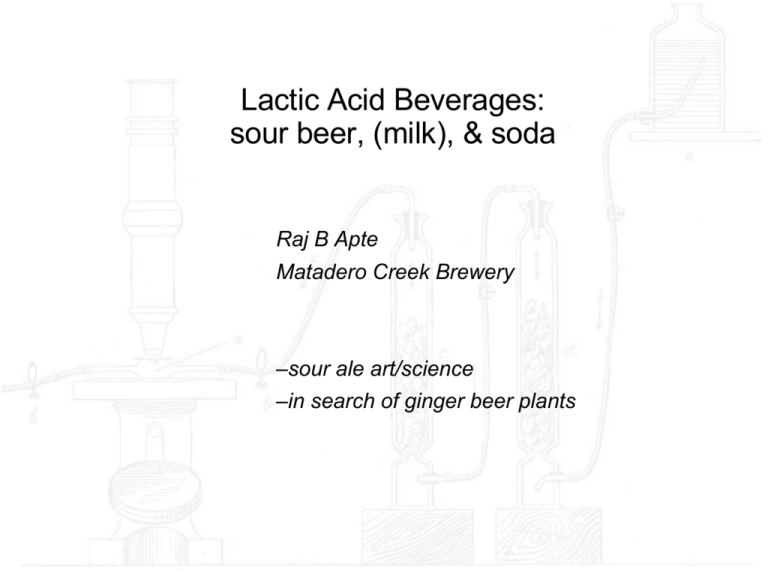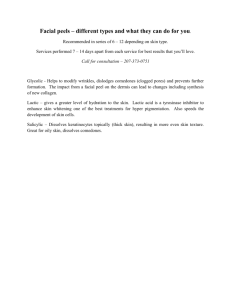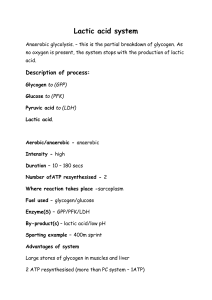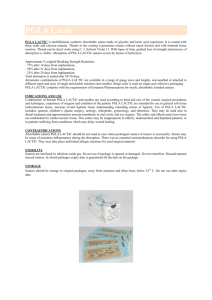Lactic Acid Beverages: sour beer, (milk), & soda
advertisement

Lactic Acid Beverages: sour beer, (milk), & soda Raj B Apte Matadero Creek Brewery –sour ale art/science –in search of ginger beer plants Chemistry of Flavor Lactobacillus Pediococcus Brettanomyces Lactic acid 4-ethyl phenol ethyl lactate 4-ethyl guaiacol Acetobacter Enterobacteriaceae ethyl acetate acetic acid Ethanol Saccharomyces Cast of characters Lactobacillus basis of yoghurt, cheese lactic acid salt resistant; hop sensitive? slime-producing Pediococcus anaerobic lactic acid hop resistant slime-producing Acetobacter aerobic pellicle forming Saccharomyces inhibited by salt sugar fungus aerobic or anaerobic produces alcohol bakers, brewers, vintners; hundreds of strains Brettanomyces british fungus; british flavor aerobic or anaerobic Bordeaux v. Davis produces alcohol or acetic acid several species; many strains (all photos stolen from websites without permission) General Fermentation salt Alcohol tolerance Saccharomyces - 20%, P Brettanomyces - 15%, P 8% 8% Lactobacillus Pediococcus Acetobacter Enterobacteriaceae molds Lactic acid Acetic acid starch pH 4.5 0.5% - 1% P 6-18% oxygen + 40-95 P 4-100 + 40-95 - 4 + - 100 -- 8% P 30 ++ 2%, P pH 4.4, P 0.5%, P 2 + - - -- 5 ++ P -- temp, F 2 2% P, pH 3.4 - time produces toxic ++ required -, + minor effect 60-150 70-110 <100 We are not in Kansas anymore glucose Entner Doudoroff Pathway There are many pathways, not just glucose → 2 x ethanol + 2 x CO2 Heterolactic Pathway ethanol CO2 Embden Meyerhof Pathway We have no way of determining alcohol accurately. lactic acid pyruvic acid 6-phosphogluconic acid 2,3-butanediol acetaldehyde CO2 lactic acid formic acid 2CO2 S CoA CO2 ethanol acetic acid ethanol CO2 , H2, H2S succinic acid acetic acid no bubbles lactic acid, formic acid, succinic acid, acetic acid H2 and CO2 bubbles acetic acid CO2 bubbles ethanol + lactic acid, ethanol Titratable acidity (TA) and pH, defined pH TA 10,000ppm = 1% like temperature like heat -log10([H+]) how many molecules of acid, by weight measures strength of acid measures quantity of acid determines biological activity determines taste use pH paper or meter titrate with base to neutrality “how much drano do you add to your beer to get pH 7.0” Acid pKa1 pKa2 Mass/ Mole Tartaric 3.02 4.54 150 Citric 3.03 4.74 192 Malic 3.40 5.05 134 Lactic 3.86 -- 90 Ascorbic 4.04 11.8 176 Acetic 4.76 -- 60 1ml of 0.1N NaOH is equivalent to 9mg lactic acid fiction TA tartaric w% % abv pH Leinenkugel lager 4.9 4.1 Preston Merlot, 2000 13.5 3.5 0.6 Landskroon Chardonnay, 2003 13.0 3.0 0.7 Verhaeghe Duchesse 6.2 3.1 1.5 Petrus Aged Pale 7.3 3.4 1.0 Cantillon Iris 5.0 3.4 1.4 Hanssens Oudbeitje 6.0 2.8 1.5 Morte Subite Peche 4.3 3.6 0.7 Kriek de Ranke 7.0 3.5 0.7 Matadero Creek Cask Porter (me) 6.0 3.3 0.6 Matadero Creek Kriek (me) 6.0 3.5 0.8 Furniture Legs and the Role of O2 Oxygen Permeability cc-mil/m2-day-Bar 200L barrels admit 20cc/L of oxygen per year = 100cc/L air. For 20L carboy, that’s 2L of air. Wood, Oak 7200 High-density polyethylene HDPE 2325 Brett can grow but will not thrive without oxygen. If you use cultured Brett, the large cell population may overcome this. Low-density polyethylene LDPE 8586 Polyethylene terephthalate copolymer PETG 400 Vinyl 20 Material Polycarbonate PC 4650 Nylon (not oriented) 79 Saran 2 Advantages of Furniture Legs v. Barrels — Oxygen diffusion — Habitat for Brettanomyces — Toast/vanillin — Autoclaveable — $1 — (danger of refermentation) negative Pasteur effect = Brett wants O2 Tank Burgundy barrel Rodenbach tank, wood, small Rodenbach tank, wood, large HDPE bucket Homebrew barrel Glass carboy, 30cm vinyl immersion tube Glass carboy, silicone stopper Glass carboy, wood stopper, cross grain Glass carboy, wood stopper, end grain Volume [L] O2 cc/L.year 300 8.5 12000 0.86 20000 0.53 20 220 40 23 20 0.31 20 17 20 0.1 20 ≈ 1.0 $1 Homebrew Oak Barrel Furniture leg: hardware removed soaked, toasted teflon tape autoclaved inoculated with B claussenii AAR Fermentation Dynamics: Succession 7000 9 5 8 6000 Acid (ppm) 6 4000 5 3000 4 3 4 pH 5000 log (CFU/ml), ethanol (abv) 7 3 2000 2 1000 1 0 0 0 12 24 36 48 60 72 84 96 108 120 Weeks enterobacteria total yeast actidione-resistant yeast acetic acid bacteria lactic acid bacteria ethanol pH acetic acid lactic acid data taken from Martens 2 Recipe 1. Mash – Grist 100% pale (wheat, caramel, &c). – 67C, 75C – boil with aged or fresh hops 2. starch may be added to wort by late additions of adjunct Primary fermentation (1wk): fruity ale 3. Chr. Hansen Harmony: S. cerevisiae, Torulaspora delbrueckii, Kluyveromyces thermotolerans (www.thewinelab.com) Secondary (6wk): acidity 4. Lactobacillus delbrueckii Tertiary (2yr): acidity and Brett – – – – any combination of lactic bacteria and Brettanomyces – wood stopper (pitched or carried) topping off Dryhop and blend – 5. Ward, Philosophical Trasactions of the Royal Society of London. B, Vol. 183 (1892) 125-197 Ward 1892, cont'd ... Recent History Bees Wine ... [is] a fermented drink which was most often produced in home kitchens and was probably most popular in the 1920's to 1950's. The culture was usually kept in a glass container by a window and grown in a mixture of water, brown sugar and black treacle (there are several variations on the exact ingredients used). It was usually drained once a week and fresh water and sugar were added. As the culture naturally multiplied any excess was either discarded or passed on to others to begin new 'Bees wine'. According to our old records 'Bees Wine' is a mixture of yeasts and bacteria. The bacteria are Lactobacilli and an unknown Gram positive rod that forms a gelatinous sheath that coils and traps the other cells in it. This is also responsible for a thick 'scum' which forms on the surface of the liquid. The yeasts that have been isolated from the mixture include Saccharomyces cerevisiae, Brettanomyces anomalus and Hansenula anomala. The gelatinous lumps formed in the 'Bees Wine' rise and fall as carbon dioxide is produced and released. Sugar, black treacle and ginger are fermented to produce a mildly alcoholic, rather sweet drink. Lemon/orange peel is sometimes added .... 'Bees Wine' has several variations and is also known as 'Ginger Beer Plant', 'Palestinian' or 'Californian' Bees or 'Balm of Gilead'. The NCYC still keeps a culture of 'Bees Wine' in the laboratory although this is purely for scientific interest and none of the present staff have tried to make the 'wine' itself from the culture. http://www.ncyc.co.uk/beeswine.php * Not a wild yeast technique * Bibliography [Ward 1892] [Pidoux 1989] [Pidoux 1990] [Leroi and Pidoux 1993] The Ginger-Beer Plant, and the Organisms Composing it: A Contribution to the Study of Fermentation-Yeasts and Bacteria. Philosophical Transactions of the Royal Society of London, B, 183 (1892), 125-197. The microbial flora of sugary kefir grain (the gingerbeer plant): biosynthesis of the grain from Lactobacillus hilgardii producing a polysaccharide gel. MIRCEN Journal 1989, 5, 223-238. Lactobacilli isolated from sugary kefir grains capable of polysaccharide production and minicell formation. J. Appl. Bacteriology 1990, 69, 311-320. Detection of interactions between yeasts and lactic acid bacteria isolated from sugary kefir grains. JAB 1993, 74, 48-53. Characterization of interactions between Lactobacillus hilgardii and Saccharomyces florentinus isolated from sugary kefir grains. JAB 1993, 74, 54-60. Found in the back of a freezer in Germany.... • Gingerbeer: □ balm of Gilead □ California wees wine □ Palestinian bees wine □ tibicos? □ Tibetan mushroom □ Japanese water crystals water/sugary kefir grains Lactobacillus hilgardii □ • □ Bacterium vermiforme • Betabacterium vermiforme • Lactobacillus brevis □ heterofermentative □ anaerobic □ mesothermic □ dextran-slime coat dextran-slime gel Saccharomyces florentinus □ • □ Saccharomyces pyriformis □ Zygosaccharomyces florentinus) Wondrous Animalcules Ginger and Mary-Ann 1” Ginger Beer Plant Milk Kefir Grain Pidoux 1989 Temperature: key to sweet, lactic soda Pidoux 1990 Leroi and Pidoux 1993: Parasitism? GBP Fermentation Dynamics 10 Lactic Acid, g/L Bacteria CFU Ethanol, g/L S. florentinus, CFU 9 8 CF/ml, g/L 7 6 data from Leroi & Pidoux 1993 5 4 3 2 1 0 0 1 2 3 4 5 day 6 7 8 9 10 Pidoux 1990: Ropiness Recipe: get your kids fermenting 1 L water 120-180g sugar, white or raw, malt 20ml lemon/lime juice and/or zest 4g ground ginger root powder 1g of cream of tartar 50g ginger beer plants No mash/boil. No sanitation Primary: 25-30C, 1-3 days, lock optional (for Brett) Secondary: strain all solids, retain plant. Correction of sugar & acidity. 25-30C, 1-2 days, in bottle/keg/siphon. Tertiary: lager 5-10C, >1wk. — spices ◦ cinnamon, cassia, coca, cola, cloves, nutmeg, vanilla, hibicus (jamaica), dried figs, mint, syrup/molasses, lemon/lime juice/zest, corriander, fennel, cardamom, star anise, rice, tamarind. ◦ dry powder, puree, whole spice, extract ◦ tisane (short or long), direct plant sources — ◦ DSM 2484 - Ginger beer plant ◦ share with others: dried culture easily mailed ◦ http://health.groups.yahoo.com/group/GingerBeer Plant/ ◦ fermentedtreasures.com Kegs, Bottles, or Siphons





